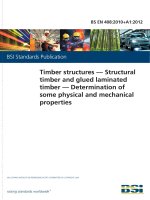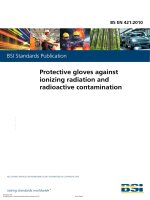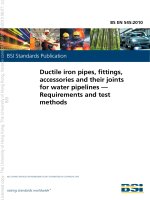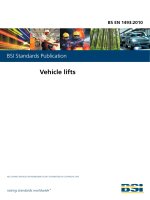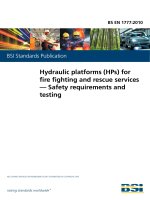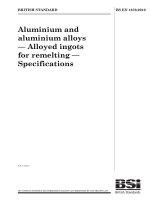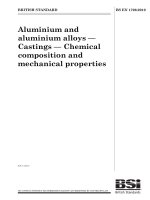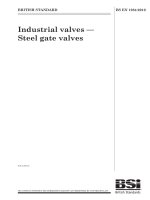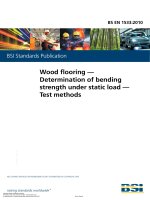Bsi bs en 61226 2010
Bạn đang xem bản rút gọn của tài liệu. Xem và tải ngay bản đầy đủ của tài liệu tại đây (832.2 KB, 36 trang )
BS EN 61226:2010
--`,,```,,,,````-`-`,,`,,`,`,,`---
Nuclear power plants –
Instrumentation and control
important to safety –
Classification of instrumentation
and control functions
Copyright European Committee for Electrotechnical Standardization
Provided by IHS under license with CENELEC
No reproduction or networking permitted without license from IHS
Not for Resale
BRITISH STANDARD
BS EN 61226:2010
National foreword
This British Standard is the UK implementation of EN 61226:2010. It is identical
to IEC 61226:2009. It super sedes BS IEC 61226:2009 which is withdrawn.
The UK participation in its preparation was entrusted to Technical Committee
NCE/8, Reactor instrumentation.
A list of organizations represented on this committee can be obtained on
request to its secretary.
This publication does not purport to include all the necessary provisions of a
contract. Users are responsible for its correct application.
© BSI 2010
ISBN 978 0 580 70133 7
ICS 27.120.20
Compliance with a British Standard cannot confer immunity from
legal obligations.
This British Standard was published under the authority of the Standards
Policy and Strategy Committee on 30 September 2009
Amendments /corrigenda issued since publication
Date
Text affected
30 June 2010
This corrigendum renumbers BS IEC 61226:2009 as
BS EN 61226:2010.
--`,,```,,,,````-`-`,,`,,`,`,,`---
Copyright European Committee for Electrotechnical Standardization
Provided by IHS under license with CENELEC
No reproduction or networking permitted without license from IHS
Not for Resale
EUROPEAN STANDARD
EN 61226
NORME EUROPÉENNE
March 2010
EUROPÄISCHE NORM
ICS 27.120.20
English version
Nuclear power plants Instrumentation and control important to safety Classification of instrumentation and control functions
(IEC 61226:2009)
Centrales nucléaires de puissance Instrumentation et contrôle-commande
importants pour la sûreté Classification des fonctions
d'instrumentation
et de contrôle-commande
(CEI 61226:2009)
Kernkraftwerke Leittechnische Systeme
mit sicherheitstechnischer Bedeutung Kategorisierung leittechnischer
Funktionen
(IEC 61226:2009)
This European Standard was approved by CENELEC on 2010-03-01. CENELEC members are bound to comply
with the CEN/CENELEC Internal Regulations which stipulate the conditions for giving this European Standard
the status of a national standard without any alteration.
Up-to-date lists and bibliographical references concerning such national standards may be obtained on
application to the Central Secretariat or to any CENELEC member.
This European Standard exists in three official versions (English, French, German). A version in any other
language made by translation under the responsibility of a CENELEC member into its own language and notified
to the Central Secretariat has the same status as the official versions.
CENELEC members are the national electrotechnical committees of Austria, Belgium, Bulgaria, Croatia, Cyprus,
the Czech Republic, Denmark, Estonia, Finland, France, Germany, Greece, Hungary, Iceland, Ireland, Italy,
Latvia, Lithuania, Luxembourg, Malta, the Netherlands, Norway, Poland, Portugal, Romania, Slovakia, Slovenia,
Spain, Sweden, Switzerland and the United Kingdom.
European Committee for Electrotechnical Standardization
Comité Européen de Normalisation Electrotechnique
Europäisches Komitee für Elektrotechnische Normung
Central Secretariat: Avenue Marnix 17, B - 1000 Brussels
© 2010 CENELEC -
All rights of exploitation in any form and by any means reserved worldwide for CENELEC members.
--`,,```,,,,````-`-`,,`,,`,`,,`---
CENELEC
Ref. No. EN 61226:2010 E
Copyright European Committee for Electrotechnical Standardization
Provided by IHS under license with CENELEC
No reproduction or networking permitted without license from IHS
Not for Resale
BS EN 61226:2010
EN 61226:2010 (E)
–2–
Foreword
The text of the International Standard IEC 61226:2009, prepared by SC 45A, Instrumentation and control
of nuclear facilities, of IEC TC 45, Nuclear instrumentation, was submitted to the CENELEC formal vote
for acceptance as a European Standard and was approved by CENELEC as EN 61226 on 2010-03-01.
Attention is drawn to the possibility that some of the elements of this document may be the subject of
patent rights. CEN and CENELEC shall not be held responsible for identifying any or all such patent
rights.
The following dates are proposed:
–
–
latest date by which the EN has to be implemented
at national level by publication of an identical
national standard or by endorsement
latest date by which the national standards conflicting
with the EN have to be withdrawn
(dop)
2011-03-01
(dow)
2013-03-01
Annex ZA has been added by CENELEC.
As stated in the nuclear safety Directive 2009/71/EURATOM, Chapter 1, Article 2, item 2, Member States
are not prevented from taking more stringent safety measures in the subject-matter covered by the
Directive, in compliance with Community law. In a similar manner, this European Standard does not
prevent Member States from taking more stringent nuclear safety measures in the subject-matter covered
by this European Standard.
__________
Endorsement notice
--`,,```,,,,````-`-`,,`,,`,`,,`---
The text of the International Standard IEC 61226:2009 was approved by CENELEC as a European
Standard without any modification.
Copyright European Committee for Electrotechnical Standardization
Provided by IHS under license with CENELEC
No reproduction or networking permitted without license from IHS
Not for Resale
–3–
BS EN 61226:2010
EN 61226:2010 (E)
CONTENTS
INTRODUCTION..................................................................................................................... 4
1
Scope ............................................................................................................................... 7
2
Normative references ....................................................................................................... 7
3
Terms and definitions ....................................................................................................... 8
4
Abbreviations ................................................................................................................. 12
5
Classification scheme ..................................................................................................... 12
5.1
5.2
5.3
6
General ................................................................................................................. 12
Background ........................................................................................................... 13
Description of categories ....................................................................................... 13
5.3.1 General ..................................................................................................... 13
5.3.2 Category A ................................................................................................ 14
5.3.3 Category B ................................................................................................ 14
5.3.4 Category C ................................................................................................ 14
5.4 Assignment criteria................................................................................................ 15
5.4.1 General ..................................................................................................... 15
5.4.2 Category A ................................................................................................ 15
5.4.3 Category B ................................................................................................ 15
5.4.4 Category C ................................................................................................ 16
Classification procedure ................................................................................................. 16
7
6.1 General ................................................................................................................. 16
6.2 Identification of design basis ................................................................................. 17
6.3 Identification and classification of functions ........................................................... 17
Assignment of technical requirements to categories ....................................................... 20
7.1
7.2
7.3
7.4
7.5
Annex A
General requirements ............................................................................................ 20
Requirements related to functions ......................................................................... 20
7.2.1 Basic requirements .................................................................................... 20
7.2.2 Specific requirements ................................................................................ 21
Requirements related to I&C systems .................................................................... 21
7.3.1 Basic requirements .................................................................................... 21
7.3.2 Specific requirements ................................................................................ 22
Requirements related to equipment ....................................................................... 24
7.4.1 Basic requirements .................................................................................... 24
7.4.2 Specific requirements ................................................................................ 24
Requirements related to quality aspects ................................................................ 25
7.5.1 Basic requirements .................................................................................... 25
7.5.2 Specific requirements ................................................................................ 25
(informative) Examples of categories ..................................................................... 29
Bibliography.......................................................................................................................... 31
Figure 1 – Method of classification........................................................................................ 19
--`,,```,,,,````-`-`,,`,,`,`,,`---
Table 1 – Tabular correlation between categories and other IEC standards .......................... 2 8
Copyright European Committee for Electrotechnical Standardization
Provided by IHS under license with CENELEC
No reproduction or networking permitted without license from IHS
Not for Resale
BS EN 61226:2010
EN 61226:2010 (E)
–4–
INTRODUCTION
a)
Technical background, main issues and organisation of the standard
This International Standard responds to an International Atomic Energy Agency (IAEA)
requirement 1 to classify nuclear power plants instrumentation and control systems according
to their importance to safety. With distributed computer based I&C systems now being used
for NPP instrumentation and control systems, the functions important to safety are distributed
over several systems or subsystems. Therefore, it is the intent of this standard to
–
classify the I&C functions important to safety into categories, depending on their
contribution to the prevention and mitigation of postulated initiating events (PIE), and to
develop requirements that are consistent with the importance to safety of each of the
categories;
–
assign specification and design requirements to I&C systems and equipment concerned
which perform the classified functions.
According to IAEA recommendation, 2 the methods of classification are primarily based on the
deterministic safety analysis, and should be complemented where appropriate by probabilistic
methods. Several possible approaches for use of probabilistic safety assessment (PSA) for
classification are described in IEC/TR 61838, “Nuclear power plants – Instrumentation and
control important to safety – Use of probabilistic safety assessment for the classification of
functions”.
This revision of the standard enables quantitative assessment to be partly taken into account.
b)
Situation of the current standard in the structure of the SC 45A standard series
IEC 61226 is directly referenced by IEC 61513 and is the second level SC 45A document
tackling the issue of categorization of functions and classification of systems.
For more details on the structure of the SC 45A standard series see item d) of this
introduction.
c)
Recommendation and limitation regarding the application of this standard
Correct classification of functions directs the appropriate degree of attention by the plant's
designers, operators and regulatory authorities to the specification, design, qualification,
quality assurance (QA), manufacturing, installation, maintenance, and testing of the systems
that ensure the safety functions.
—————————
1 IAEA NS-R-1 requirement 5.1.
2
The NS-R-1, section 5.2 requires that the method for classifying the safety significance of a structure, system
or component shall be primarily based on deterministic methods complemented where appropriate by
probabilistic methods and sound engineering judgment taking into account factors such as
a) the safety function(s) to be performed;
b) the consequences of failure to perform the function;
c) the probability that it (the I&C system) will be required to perform a safety function;
d) the time following a PIE at which, or the period throughout which it (the I&C system) will be called upon to
operate.
--`,,```,,,,````-`-`,,`,,`,`,,`---
Copyright European Committee for Electrotechnical Standardization
Provided by IHS under license with CENELEC
No reproduction or networking permitted without license from IHS
Not for Resale
–5–
BS EN 61226:2010
EN 61226:2010 (E)
This standard establishes the criteria and methods to be used to assign the I&C functions of a
NPP to three categories A, B and C, which depend on the importance of the function for
safety, and an unclassified category for functions with no direct safety role. It outlines generic
requirements for each category, and specifies basic technical requirements for matters such
as QA, reliability, testing and maintenance.
The category to which a function is assigned determines generic and specific technical
requirements. Generic requirements for each function are based on providing the appropriate
level of assurance that it will be executed on demand with the required performance and
reliability level. This applies to the aspects of functionality, reliability, performance,
environmental durability and QA. The level of assurance to be shown for each of these
aspects must be consistent with the importance of the function to safety.
i)
Assurance of functionality is established by the creation of a complete and comprehensive
requirements specification, and the application of appropriate standards and codes.
ii) Assurance of reliability is provided by the selection of appropriate components, structures
and levels of redundancy and diversity in association with physical separation and/or
barriers, electrical isolation and periodic testing during service.
iii) Assurance of performance is gained by the creation of specifications of the required
performance, the application of QA procedures, verification and validation processes
during design and manufacture, pre-service testing of the individual and integrated
systems and equipment, and testing during service.
iv) Assurance of environmental durability is established by equipment qualification
programmes to ensure that ageing effects and environmental conditions that exist when
the equipment is required to operate do not degrade its performance below that required.
v) Assurance that the aspects of functionality, performance, environmental durability and
reliability have been properly considered at each stage from conception, through design,
manufacture, test, installation, commissioning and entry into service is provided by
carrying out each stage of the work under the control of an appropriate QA program.
Throughout this standard, the auxiliary "shall" indicates requirements that are mandatory for
compliance with the standard, the auxiliary "should" indicates requirements that are not
mandatory for compliance with the standard but are strongly recommended and the auxiliary
"may" indicates requirements that are optional.
d)
Description of the structure of the SC 45A standard series and relationships with
other IEC documents and other bodies documents (IAEA, ISO)
The top-level document of the IEC SC 45A standard series is IEC 61513. It provides general
requirements for I&C systems and equipment that are used to perform functions important to
safety in NPPs. IEC 61513 structures the IEC SC 45A standard series.
IEC 61513 refers directly to other IEC SC 45A standards for general topics related to
categorization of functions and classification of systems, qualification, separation of systems,
defence against common cause failure, software aspects of computer-based systems,
hardware aspects of computer-based systems, and control room design. The standards
referenced directly at this second level should be considered together with IEC 61513 as a
consistent document set.
At a third level, IEC SC 45A standards not directly referenced by IEC 61513 are standards
related to specific equipment, technical methods, or specific activities. Usually these
documents, which make reference to second-level documents for general topics, can be used
on their own.
A fourth level extending the IEC SC 45A standard series, corresponds to the technical reports
which are not normative.
--`,,```,,,,````-`-`,,`,,`,`,,`---
Copyright European Committee for Electrotechnical Standardization
Provided by IHS under license with CENELEC
No reproduction or networking permitted without license from IHS
Not for Resale
BS EN 61226:2010
EN 61226:2010 (E)
–6–
IEC 61513 has adopted a presentation format similar to the basic safety publications of
IEC 61508 series with an overall safety life-cycle framework and a system life-cycle
framework and provides an interpretation of the general requirements of IEC 61508-1,
IEC 61508-2 and IEC 61508-4, for the nuclear application sector. Compliance with IEC 61513
will facilitate consistency with the requirements of IEC 61508 as they have been interpreted
for the nuclear industry. In this framework, IEC 60880 and IEC 62138 correspond to
IEC 61508-3 for the nuclear application sector.
IEC 61513 refers to ISO, as well as to IAEA 50-C-QA (now replaced by IAEA GS-R-3) for
topics related to quality assurance (QA).
The IEC SC 45A standards series consistently implements and details the principles and
basic safety aspects provided in the IAEA code on the safety of NPPs and in the IAEA safety
series, in particular the requirements NS-R-1, establishing safety requirements related to the
design of nuclear power plants, and the safety guide NS-G-1.3 dealing with instrumentation
and control systems important to safety in nuclear power plants. The terms and definitions
used by SC 45A standards are consistent with those used by the IAEA.
--`,,```,,,,````-`-`,,`,,`,`,,`---
Copyright European Committee for Electrotechnical Standardization
Provided by IHS under license with CENELEC
No reproduction or networking permitted without license from IHS
Not for Resale
–7–
BS EN 61226:2010
EN 61226:2010 (E)
NUCLEAR POWER PLANTS –
INSTRUMENTATION AND CONTROL IMPORTANT TO SAFETY –
CLASSIFICATION OF INSTRUMENTATION AND CONTROL FUNCTIONS
1
Scope
This International Standard establishes a method of classification of the information and
command functions for nuclear power plants, and the I&C systems and equipment that
provide those functions, into categories that designate the importance to safety of the
function. The resulting classification then determines relevant design criteria.
The design criteria are the measures of quality by which the adequacy of each function in
relation to its importance to plant safety is ensured. In this standard, the criteria are those of
functionality, reliability, performance, environmental durability (including seismic) and quality
assurance (QA).
This standard is applicable to all the information and command functions and the instrumentation and control (I&C) systems and equipment that provide those functions. The functions,
systems and equipment under consideration provide automated protection, closed or open
loop control and information to the operating staff. They keep the NPP conditions inside the
safe operating envelope and provide automatic actions, or enable manual actions, that
prevent or mitigate accidents, or that prevent or minimize radioactive releases to the site or
wider environment. The I&C functions that fulfil these roles safeguard the health and safety of
the NPP operators and the public.
This standard follows the general principles given in IAEA safety code NS-R-1 and safety
guide NS-G-1.3, and it defines a structured method of applying the guidance contained in
those codes and standards to the I&C systems that perform functions important to safety in a
NPP. This standard should be read in association with the IAEA guides and IEC 61513 in
implementing the requirements of IEC 61508 series.
2
Normative references
The following referenced documents are indispensable for the application of this document.
For dated references, only the edition cited applies. For undated references, the latest edition
of the referenced document (including any amendments) applies.
IEC 60671:2007, Nuclear power plants – Instrumentation and control systems important to
safety – Surveillance testing
IEC 60709, Nuclear power plants – Instrumentation and control systems important to safety –
Separation
IEC 60780, Nuclear power plants – Electrical equipment of the safety system – Qualification
IEC 60812, Analysis techniques for system reliability – Procedure for failure mode and effects
analysis (FMEA)
IEC 60880:2006, Nuclear power plants – Instrumentation and control systems important to
safety – Software aspects for computer-based systems performing category A functions
IEC 60964, Nuclear power plants – Control rooms – Design
--`,,```,,,,````-`-`,,`,,`,`,,`---
Copyright European Committee for Electrotechnical Standardization
Provided by IHS under license with CENELEC
No reproduction or networking permitted without license from IHS
Not for Resale
BS EN 61226:2010
EN 61226:2010 (E)
–8–
IEC 60965, Supplementary control points for reactor shutdown without access to the main
control room
IEC 60980, Recommended practices for seismic qualification of electrical equipment of the
safety system for nuclear generating stations
IEC 60987, Nuclear power plants – Instrumentation and control important to safety –
Hardware design requirements for computer-based systems
IEC 61000-4 (all parts), Electromagnetic compatibility (EMC) – Part 4: Testing and
measurement techniques
IEC 61000-6-2, Electromagnetic compatibility (EMC) – Part 6-2: Generic standards –
Immunity for industrial environments
IEC 61513:2001, Nuclear power plants – Instrumentation and control for systems important to
safety – General requirements for systems
IEC 61771, Nuclear power plants – Main control room – Verification and validation of design
IEC 61772, Nuclear power plants – Main control room – Application of visual display units
(VDU)
IEC 61839, Nuclear power plants – Design of control rooms – Functional analysis and
assignment
IEC 62138, Nuclear power plants – Instrumentation and control important for safety –
Software aspects for computer-based systems performing category B or C functions
IAEA NS-R-1:2000, Safety of nuclear power plants: Design
IAEA GS-R-3:2006, The management system for facilities and activities (available in English
only)
IAEA NS-G-1.3:2002, Instrumentation and Control Systems Important to Safety in Nuclear
Power Plants
3
Terms and definitions
For the purposes of this document, the following terms and definitions apply.
3.1
anticipated operational occurrence
operational process deviating from normal operation which is expected to occur at least once
during the operating lifetime of a facility but which, in view of appropriate design provisions,
does not cause any significant damage to items important to safety nor lead to accident
conditions
--`,,```,,,,````-`-`,,`,,`,`,,`---
[IAEA Safety Glossary:2007]
Copyright European Committee for Electrotechnical Standardization
Provided by IHS under license with CENELEC
No reproduction or networking permitted without license from IHS
Not for Resale
–9–
BS EN 61226:2010
EN 61226:2010 (E)
3.2
common cause failure
CCF
failure of two or more structures, systems or components due to a single specific event or
cause
[IAEA Safety Glossary:2007]
3.3
design basis accident
DBA
accident conditions against which a facility is designed according to established design
criteria, and for which the damage to the fuel and the release of radioactive material are kept
within authorized limits
[IAEA Safety Glossary:2007]
3.4
design basis event
DBE
group of design basis accidents and anticipated operational occurrences
NOTE
See also 3.13.
3.5
diversity
presence of two or more redundant systems or components to perform an identified function,
where the different systems or components have different attributes so as to reduce the
possibility of common cause failure, including common mode failure
[IAEA Safety Glossary:2007]
NOTE The following definition was given in 3.5 of IEC 60880 for the term “diversity”: Existence of two or more different
ways or means of achieving a specified objective. Diversity is specifically provided as a defence against common
cause failure. It may be achieved by providing systems that are physically different from each other or by functional
diversity, where similar systems achieve the specified objective in different ways. It is totally consistent with the
IAEA definition given here.
--`,,```,,,,````-`-`,,`,,`,`,,`---
3.6
equipment
one or more parts of a system. An item of equipment is a single definable (and usually
removable) element or part of a system
[IEC 61513, 3.17, modified]
3.7
function
specific purpose or objective to be accomplished, that can be specified or described without
reference to the physical means of achieving it
3.8
functionality
attribute of a function which defines the operations which transform input information into
output information
[IEC 61513, 3.25]
Copyright European Committee for Electrotechnical Standardization
Provided by IHS under license with CENELEC
No reproduction or networking permitted without license from IHS
Not for Resale
BS EN 61226:2010
EN 61226:2010 (E)
– 10 –
3.9
human factor engineering programme
programme that describes at least the human factors organisation, role and mission of human
factors specialists and team, human factors activities and their integration in the design and
validation process, list of deliverables to be provided at each step of the program
3.10
item important to safety
item that is part of a safety group and/or whose malfunction or failure could lead to radiation
exposure of the site personnel or members of the public.
Items important to safety include:
a) those structures, systems and components whose malfunction or failure could lead to
undue radiation exposure of the site personnel or members of the public;
b) those structures, systems and components
occurrences from leading to accident conditions;
that
prevent
anticipated
operational
c) those features which are provided to mitigate the consequences of malfunction or failure
of structures, systems or components.
[IAEA Safety Glossary: 2007]
NOTE
Items important to safety considered in this standard are mainly I&C systems important to safety.
3.11
non-hazardous stable state
state of the plant, where stabilisation of any transient has been achieved, the reactor is
subcritical, adequate heat removal is ensured and radioactive releases are limited
NOTE A transient is considered to be stabilised when, for all safety significant parameters, the margins (e.g.
between the heat removal capacity and heat generation) are either stable or increasing, or sufficient margin
remains to cover all expected physical processes.
3.12
performance
effectiveness with which an intended function is carried out (e.g. time response, accuracy,
sensitivity to parameter changes)
3.13
plant states
Operational states
Accident conditions
Design basis events
Normal operation
Anticipated operational
occurrences
a)
Design basis
accidents
Beyond design basis
accidents
b)
Severe accidents
Accident management
a) Accident conditions which are not explicitly considered design basis accidents but which are encompassed by
them.
b) Beyond design basis accidents without significant core degradation.
NOTE This definition is consistent with the one of the IAEA safety glossary. It just indicates the position of the
concept of “design basis event” compared to the other concepts.
--`,,```,,,,````-`-`,,`,,`,`,,`---
Copyright European Committee for Electrotechnical Standardization
Provided by IHS under license with CENELEC
No reproduction or networking permitted without license from IHS
Not for Resale
– 11 –
BS EN 61226:2010
EN 61226:2010 (E)
3.14
postulated initiating event
PIE
event identified during design as capable of leading to anticipated operational occurrences or
accident conditions
[IAEA Safety Glossary:2007]
3.15
redundancy
provision of alternative (identical or diverse) structures, systems or components, so that any
one can perform the required function regardless of the state of operation or failure of any
other
[IAEA Safety Glossary:2007]
3.16
safety group
assembly of equipment designated to perform all actions required for a particular postulated
initiating event to ensure that the limits specified in the design basis for anticipated
operational occurrences and design basis accidents are not exceeded
[IAEA Safety Glossary:2007]
3.17
safety related system
a system important to safety that is not part of a safety system
[IAEA Safety Glossary:2007]
3.18
safety system
a system important to safety, provided to ensure the safe shutdown of the reactor and the
residual heat removal from the core, or to limit the consequences of anticipated operational
occurrences and design basis accident
[IAEA Safety Glossary:2007]
3.19
single failure
a failure which results in the loss of capability of a system or component to perform its
intended safety function(s), and any consequential failure(s) which result from it
[IAEA Safety Glossary:2007]
3.20
system
set of components which interact according to a design, where an element of a system can be
another system, called a subsystem
3.21
type test
conformity test made on one or more items representative of the production
[IEV 394-40-02]
Copyright European Committee for Electrotechnical Standardization
Provided by IHS under license with CENELEC
No reproduction or networking permitted without license from IHS
Not for Resale
--`,,```,,,,````-`-`,,`,,`,`,,`---
[IEC 61513, 3.61]
BS EN 61226:2010
EN 61226:2010 (E)
– 12 –
3.22
unacceptable consequence
consequence of an operational state or of a PIE, that exceeds specified limits for the
corresponding plant states, in terms of releases at the site or to the wider environment
NOTE Additional limits, such as unacceptable fuel damage, or damage to other main components may also be
specified on a national basis. This might be either a massive, uncontrolled release caused by events with a
frequency that is beyond the NPP's design basis, or events with a frequency that is in the design basis but leading
to a magnitude exceeding specified limits. Additional limits, such as unacceptable fuel damage may also be
specified. This might be damage to the fuel cladding that leads to an unacceptable increase in the activity of the
primary coolant, or structural damage to the fuel that impairs the ability to cool it. Damage to the other barriers may
also be considered as unacceptable consequence.
4
Abbreviations
ALARA As low as reasonably achievable
DBA
Design basis accident
DBE
Design basis event
FAT
Factory acceptance test
FMEA
Failure modes and effects analysis
HMI
Human machine interface
IAEA
International Atomic Energy Agency
I&C
Instrumentation and control
NPP
Nuclear power plant
PIE
Postulated initiating event
PRA
Probabilistic risk assessment
QA
Quality assurance
SAT
Site acceptance test
5
5.1
Classification scheme
General
Functions to be performed by I&C systems shall be assigned to categories according to their
importance to safety. The importance to safety of a function shall be identified by means of
the consequences in the event of its failure when it is required to be performed and the
consequences in the event of a spurious actuation. The category determines the design and
quality requirements for I&C systems and equipment. These requirements shall be defined
independently from the technology of the equipment to be applied. Subclause 5.2 provides the
background to the classification scheme.
Subclause 5.3 describes the three categories that are used to classify functions. The
categories are based upon those defined originally in the first edition of IEC 61226 published
in 1993.
Subclause 5.4 presents the assignment criteria for each category.
Clause 6 provides guidance on the classification process.
Clause 7 provides the technical requirements for each of the three categories. Most of the
requirements apply to the systems and equipment that perform the functions, but some
requirements apply only to the functions.
Annex A contains typical examples of the classification of NPP I&C functions. It is only for
information because it may depend on the reactor type.
--`,,```,,,,````-`-`,,`,,`,`,,`---
Copyright European Committee for Electrotechnical Standardization
Provided by IHS under license with CENELEC
No reproduction or networking permitted without license from IHS
Not for Resale
– 13 –
5.2
BS EN 61226:2010
EN 61226:2010 (E)
Background
The principle of defence in depth is firmly established in the safety design basis of nuclear
power plants. The fundamental idea is that there should be several layers or echelons of
defence in the prevention of unsafe conditions, and that the prevention of unsafe conditions,
before mitigation is required, is always to be preferred. Because of the large number of
functions that are required to operate and keep safe a NPP, a number that increases with the
principle of defence in depth, it is important that the significance to safety of each function is
known.
IAEA safety standard series NS-R-1 establishes the idea of classification of NPP systems
according to their importance to safety, and gives examples of the classification of the major
systems of several types of NPP. All structures, systems and components, including software
for instrumentation and control (I&C), that are items important to safety, shall be first
identified and then classified on the basis of their function and significance with regard to
safety. They shall be designed, constructed and maintained such that their quality and
reliability is commensurate with this classification.
The IAEA safety guide NS-G-1.3 gives guidance on the classification of systems according to
the importance to safety of the functions they perform. It introduces time factors such as
–
the duration that the I&C system is needed once it has been initiated;
–
the time for which alternative actions can be taken;
–
the timeliness by which hidden faults can be detected and remedied.
The safety importance of, and the corresponding requirements placed on, parts of the safety
systems and safety related I&C systems will differ, so that it is appropriate to assign them to
different safety classes. Some I&C systems can have a significant effect on safety and
therefore require appropriate attention. Other I&C systems have intermediate, low, or no
significance to safety. They have correspondingly less stringent requirements for ensuring
system performance and safety justification, and therefore have different technical
requirements.
National application of the principles and criteria of this standard may assign differing
nomenclature to categories A, B and C. The national application shall be according to the
principles, criteria and associated requirements given in this standard. This shall involve
establishing and documenting an appropriate correspondence to the categories defined.
5.3
5.3.1
Description of categories
General
I&C systems in NPPs perform functions with different levels of importance to safety. The
importance to safety of each I&C function depends upon its role in achieving and maintaining
safety, the potential consequence of failure of the function to operate when required, and the
probability of these consequences. Therefore, an initial safety analysis of the specific NPP
design is required to be completed prior to the classification of the I&C functions. The severity
of the potential consequences in the case of a postulated failure of an I&C function, defines
the level of assurance that is required for the various attributes of the systems and equipment
which deliver the function, most notably that of functionality, performance and reliability.
Copyright European Committee for Electrotechnical Standardization
Provided by IHS under license with CENELEC
No reproduction or networking permitted without license from IHS
Not for Resale
--`,,```,,,,````-`-`,,`,,`,`,,`---
This standard extends the classification strategy presented in IAEA Safety Guide NS-G-1.3,
and establishes the criteria and methods to be used to assign the I&C functions of a NPP to
one of the three categories A, B and C, depending on their importance to safety, or to an
unclassified category for functions with no direct safety role. I&C functions falling within the
boundary of the safety systems will generally be assigned to category A or B. I&C functions
defined as safety related will generally be assigned to categories B or C.
BS EN 61226:2010
EN 61226:2010 (E)
– 14 –
For the design, assessment and licensing procedures, safety categories A, B and C are
defined, with associated sets of technical and quality requirements on the properties of the
I&C systems to be applied for the design and implementation of I&C systems and equipment
important to safety.
5.3.2
Category A
Category A denotes the functions that play a principal role in the achievement or maintenance
of NPP safety to prevent DBE from leading to unacceptable consequences. This role is
essential at the beginning of the transient when no alternative actions can be taken, even if
hidden faults can be detected. These functions play a principal role in the achievement or
maintenance of the non-hazardous stable state 3. If specified manual actions are provided to
reach the non-hazardous stable state, factors such as the availability of redundant, validated,
information sources, sufficient duration of the grace time for operator evaluation of alternative
sources of information, and whether the manual actions are the only possibility for mitigation
of this sequence of events to preserve NPP safety, have to be considered.
Category A also denotes functions whose failure could directly lead to accident conditions
which may cause unacceptable consequences if not mitigated by other category A functions.
Category A functions have high reliability requirements. Consequently, it may be necessary to
limit their functionality and complexity.
5.3.3
Category B
--`,,```,,,,````-`-`,,`,,`,`,,`---
Category B denotes functions that play a complementary role to the category A functions in
the achievement or maintenance of NPP safety, especially the functions required to operate
after the non-hazardous stable state has been achieved, to prevent design basis events
(DBE) from leading to unacceptable consequences, or mitigate the consequences of DBE.
The operation of a category B function may avoid the need to initiate a category A function.
Category B functions may improve or complement the execution of a category A function in
mitigating the consequences of a DBE, so that plant or equipment damage or activity release
may be avoided or minimised.
Category B also denotes functions whose failure could initiate a DBE or worsen the severity of
a DBE. Because of the presence of a category A function to provide the ultimate prevention of
or mitigation of the consequences of a DBE, the safety requirements for the category B
function need not be as high as those for the category A function. This allows, if necessary,
the category B functions to be of higher functionality than category A functions in their method
of detecting a need to act or in their subsequent actions.
5.3.4
Category C
Category C denotes functions that play an auxiliary or indirect role in the achievement or
maintenance of NPP safety. Category C includes functions that have some safety
significance, but are not category A or B. They can be part of the total response to DBA but
not be directly involved in mitigating the physical consequences of the accident, or be
functions necessary for beyond design basis accidents.
—————————
3 In order to cope with rapid transients, the plant is controlled during this phase by automatic actions. For slower
transients, stable conditions can be obtained using manual actions, provided such actions are considered after
a grace time. This type of grace time represents a design requirement of the plant corresponding to a delay of
diagnosis and action, and based on human factors considerations. It does not mean that manual actions are not
permitted during that time. In some countries, and for older plants, the limit of category A may be this grace
time, in place of the non-hazardous stable state.
Copyright European Committee for Electrotechnical Standardization
Provided by IHS under license with CENELEC
No reproduction or networking permitted without license from IHS
Not for Resale
– 15 –
5.4
BS EN 61226:2010
EN 61226:2010 (E)
Assignment criteria
5.4.1
General
The criteria that shall be applied for assignment of functions to categories A, B and C are
given below.
If a function does not meet any of the criteria given below, then it shall be "non-classified"
(NC).
In the case of multiple assignment, the final assignment of a function to a category shall be
the highest relevant category.
The final assignment of the function may be modified using probabilistic methods in
consistency with the principles outlined in 6.3.
5.4.2
Category A
An I&C function shall be assigned to category A if it meets any of the following criteria:
a) functions required to reach the non-hazardous stable state, to prevent a DBE from leading
to unacceptable consequences, or to mitigate its consequences;
--`,,```,,,,````-`-`,,`,,`,`,,`---
b) functions, the failure or spurious actuation of which would lead to unacceptable
consequences, and for which no other category A function exists that prevents the
unacceptable consequences;
c) functions required to provide information and control capabilities that allow specified
manual actions necessary to reach the non-hazardous stable state.
5.4.3
Category B
An I&C function shall be assigned to category B if it meets any of the following criteria and is
not otherwise assigned to category A:
a) functions required after the non-hazardous stable state of a DBE has been reached, to
prevent it from leading to unacceptable consequences, or to mitigate the consequences;
b) functions required to provide information or control capabilities that allow specified manual
actions necessary after the non-hazardous stable state has been reached to prevent a
DBE from leading to unacceptable consequences, or mitigate the consequences;
c) functions, the failure of which during normal operation, would require the operation of a
category A function to prevent an accident whose study is required;
d) functions to reduce considerably the frequency of a DBE as claimed in the safety analysis;
e) plant process control functions operating so that the main process variables are
maintained within the limits assumed in the safety analysis, if these control functions are
the only means of control of these variables. If different means are provided, clause 5.4.4
a) may apply;
f)
functions used to prevent or mitigate a radioactive release or fuel degradation outside of
the limits and conditions of normal operation as defined in the safety analysis;
NOTE 1 This refers to functions that are not already covered by the analysis of DBE leading to category A
classification.
Copyright European Committee for Electrotechnical Standardization
Provided by IHS under license with CENELEC
No reproduction or networking permitted without license from IHS
Not for Resale
BS EN 61226:2010
EN 61226:2010 (E)
– 16 –
g) functions that provide continuous or intermittent tests or monitoring of functions in
category A to indicate their continued availability for operation and alert control room staff
to their failures, if no alternative means (e.g. periodic tests) are provided to verify their
availability 4.
NOTE 2 Where the monitoring function is the only means of detecting otherwise unrevealed failures, then
assigning the function to category B ensures that the equipment providing the function is suitably qualified.
5.4.4
Category C
An I&C function shall be assigned to category C if it meets any of the following criteria and is
not otherwise assigned to category A or category B:
a) plant process control functions operating so that the main process variables are
maintained within the limits assumed in the safety analysis not covered by 5.4.3 e). In
case a combination of category C functions is used, a justification of sufficiency shall be
provided;
NOTE 1 According to national practices a possible acceptable application of clause 5.4.4 a) is the combination of
a regulation function and suitable manual actuation based on independent alarms including a justification of the
use of manual action.
b) functions used to prevent or mitigate a minor radioactive release, or minor degradation of
fuel, within the NPP design basis;
NOTE 2 A minor release or minor fuel degradation is considered to be that which falls within the normal limits and
conditions of operation (e.g. discharge limits).
c) functions that provide continuous or intermittent tests or monitoring of functions in
category A and B to indicate their continued availability for operation and alert control
room staff to their failures, and are not classified category B according to 5.4.3 g);
d) functions necessary to reach the safety probabilistic goals including those to reduce the
expected frequency of a DBE;
e) functions to reduce the demands on a category A function, as claimed in the safety
analysis;
f)
functions to monitor and take mitigating action following internal hazards within the NPP
design basis (e.g. fire, flood);
g) functions to warn personnel or to ensure personnel safety during or following events that
involve or result in release of radioactivity in the NPP, or risk of radiation exposure;
h) functions to monitor and take mitigating action following natural events (e.g. seismic
disturbance, extreme wind);
i)
functions provided for the benefit of the accident management strategy to reach and
maintain a safe state for beyond design accidents;
j)
functions provided to minimise the consequences of severe accidents;
k) functions which provide access control for the NPP.
6
6.1
Classification procedure
General
An outline of the procedure is shown in Figure 1.
—————————
4 Subclause 4.2.6 of IEC 60671 provides further guidance on the class of equipment used to implement such
functions and in particular notes that where: “test features could interfere in an inappropriate manner with the
proper operation of the system or equipment performing the function important to safety, it shall be assigned to
the same category”
--`,,```,,,,````-`-`,,`,,`,`,,`---
Copyright European Committee for Electrotechnical Standardization
Provided by IHS under license with CENELEC
No reproduction or networking permitted without license from IHS
Not for Resale
BS EN 61226:2010
EN 61226:2010 (E)
– 17 –
6.2
Identification of design basis
A main input to the classification process of functions is the nature of the NPP and the reactor
type (e.g. PWR (pressurized water reactor), BWR (boiling water reactor) or other reactor
type), the associated PIEs, and the major design criteria on redundancy of mechanical and
electrical systems and equipment. Another main input is the identification of the major
mitigation functions, and their supporting functions, for each PIE.
The assessment of the frequency and consequences of PIEs leads to the identification of
DBEs representing the design base of the plant. When considering the design features of the
plant the specified ranges of operational states and accident conditions and the defined
radiological limits have to be reflected. Individual safety principles that together make up an
“integrated overall safety approach” ensure the safety of a NPP. These principles are used in
the design by considering the identified DBEs and successive physical barriers to keep
radioactive exposure within permitted limits. The DBEs and the major design criteria
(redundancy, separation, etc) of the plant, as well as the identification of the prevention and
mitigation functions, and their supporting functions are the main input to the classification
process.
The importance to safety of each I&C function depends upon the role for achieving and
maintaining the NPP safety and the potential consequence of failure of the function to operate
when required. Therefore, an initial safety analysis of the specific NPP design is required to
be completed prior to the classification of the I&C functions.
6.3
Identification and classification of functions
At an early stage in the design of the NPP, the safety relevant functions shall be identified.
The process of identifying these functions and assigning them to the I&C function or to the
human operators should be carried out according to IEC 60964. Following this initial
identification of a function, a category for each function shall be assigned according to the
criteria of Clause 5.
The method for classifying the safety significance of function shall primarily be based on
deterministic methods, complemented where appropriate by probabilistic methods and
engineering judgment, with account taken of factors such as:
•
the safety function(s) to be performed;
•
the role of the function in preventing or mitigating postulated initiating events;
•
the role of the function during all operating modes (e.g. start-up, normal operation,
refuelling, etc);
•
the role of the function following PIEs such as natural events (e.g. seismic disturbance,
flood, extreme wind, lightning) and internal hazards (e.g. fire, internal flood, missiles,
radioactive release from adjacent unit or chemical releases from other plants or
industries);
•
the consequences of failure of the I&C functions;
•
the effects of spurious actuation of the I&C functions;
•
the probability that it will be required to perform a function important to safety;
•
the time following a DBE at which, or during which it will be required to operate;
•
the maintenance, repair and testing strategy.
It will not be possible to identify in detail all the functions at an early stage in the design
process, as the characteristics of the NPP will not then have been defined fully. The process
of identification and classification of the functions must therefore continue iteratively
throughout the design phase. Where an initial assignment of a function to a category is
uncertain, then an explanatory note should be added to the categorisation.
--`,,```,,,,````-`-`,,`,,`,`,,`---
Copyright European Committee for Electrotechnical Standardization
Provided by IHS under license with CENELEC
No reproduction or networking permitted without license from IHS
Not for Resale
BS EN 61226:2010
EN 61226:2010 (E)
– 18 –
Since individual functions may be involved in the implementation of several aspects of the
requirements specification, such functions may be assigned to several categories. In that
case, the highest category assigned shall be applied.
--`,,```,,,,````-`-`,,`,,`,`,,`---
As the redundancy, diversity and other technical requirements of the functions are determined
more exactly, for example after the safety analysis progresses and the operating procedures
are developed, the classification list shall be refined and revised, to derive a final list. This list
shall be documented and maintained under configuration control since it will be required by
plant/I&C designers during the life of the NPP. Also, this list may be required by the regulatory
authorities.
Copyright European Committee for Electrotechnical Standardization
Provided by IHS under license with CENELEC
No reproduction or networking permitted without license from IHS
Not for Resale
